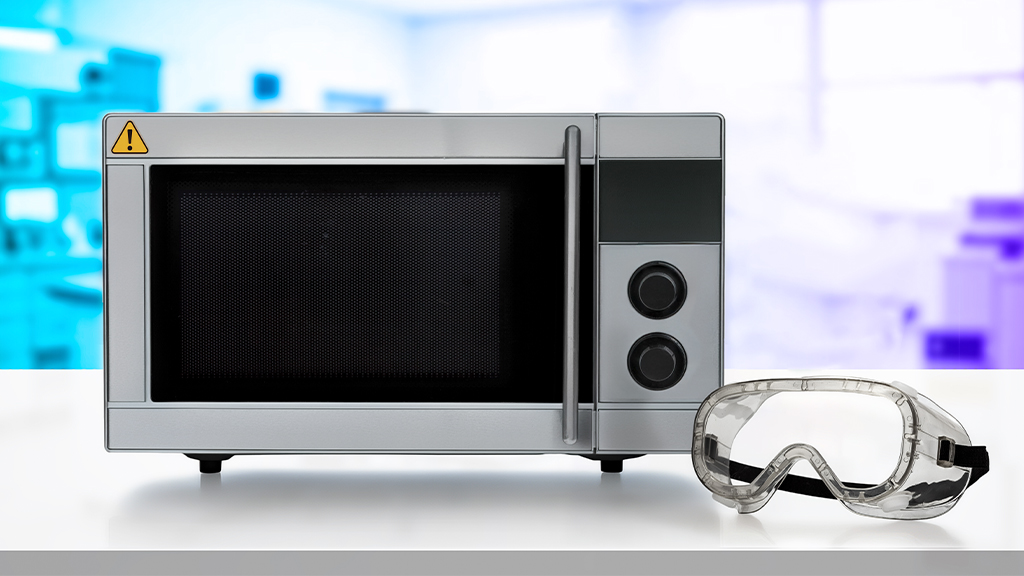Safety Blog
Safety Protocols for Microwave Use in Science/STEM Instructional Spaces
By Ken Roy
Posted on 2025-11-03

Disclaimer: The views expressed in this blog post are those of the author(s) and do not necessarily reflect the official position of the National Science Teaching Association (NSTA).
Microwaves—Not Your Normal Kitchen Appliance
Microwaves are often used in science/STEM laboratory instructional spaces and related areas (preparation rooms). However, there are potential safety hazards and resulting health and safety risks if appropriate safety protocols involving safety actions are not followed. Safety incidents such as fires, smoke, and explosions resulting from improper use of microwaves have occurred in laboratories. This is why microwave use is subject to strict safety guidelines/protocols and stipulations, given they are not considered ordinary "kitchen appliances" in this context. Instead, they need to be treated as laboratory equipment that may introduce potential hazards and resulting health and safety risks if misused.
General Microwave Safety Protocols
Here’s a breakdown of safety protocols commonly applied in science/STEM laboratory instructional spaces and related areas such as prep rooms when working with microwaves.
A. Dedicated Use
• A microwave used in a lab must be dedicated to laboratory purposes only (not food).
• It should be labeled clearly: “For Laboratory Use Only—Not for Food.”
• Using the same unit for heating chemicals/biological samples and food is a contamination hazard.
B. Placement
• Should be located in a well-ventilated area away from flammable materials.
• Must be plugged directly into a wall electrical receptacle that is GFI (ground fault interrupter)–protected (no extension cords, per Occupational Safety and Health Administration [OSHA] electrical safety).
• Should not block egress paths or crowd benchtops.
C. Training and SOPs
• Users must be trained on safer operation (time, container types, no sealed vessels).
• Written Standard Operating Procedures (SOPs) should exist for the specific laboratory instructional space and/or related area.
Chemical and Biological Use
Specific chemical and biological hazards and resulting risks must be addressed, including the following.
A. Chemicals
• Do not heat flammable solvents unless the microwave is designed as an explosion-proof laboratory-grade microwave.
• Glassware should be microwave-safe (no metal, foil, or cracked containers).
• Always leave venting (e.g., watch glass or loose caps) to prevent pressure buildup.
B. Biologicals
• Often used for melting agar, warming media, or sterilizing (non-critical) items.
• Spills must be cleaned immediately, as residues can carbonize or release fumes.
Safety Requirements
Laboratory instructors need to be aware of specific safety requirements to protect employees and their students. The following are examples of these safety requirements.
Personal Protective Equipment (PPE)
• At minimum—sanitized indirectly vented chemical splash goggles, lab coat, vinyl or nitrile gloves.
• Secondary containment (e.g., a tray) under containers to catch spills.
Inspection and Maintenance
• Check seals and doors regularly before each usage.
• Never operate a microwave with damaged door seals or hinges (risk of radiation leakage).
Emergency Considerations
• Post signage on entrance door: “Microwave Oven for Laboratory Use Only—Not for Food or Beverages.”
• Post signs near the microwave that warn about hot containers.
• Fire extinguisher nearby (Class ABC).
Regulatory References
Legal safety standards and better professional safety practices are also important for laboratory instructional space teachers to be aware of and adopt.
• OSHA Laboratory Standard (29 CFR 1910.1450). Requires hazard evaluation, SOPs, and PPE for all equipment and procedures.
• School Science Safety Guidelines (NSTA, American Chemical Society, state Department of Education safety manuals). Explicitly require labeling and prohibiting food use.
• National Fire Protection Association (NFPA) 45 (Fire Protection for Laboratories). Placement and hazard controls apply if heating flammables.
Final Thoughts
Microwave usage is allowed in laboratory instructional spaces and related areas such as prep rooms. Microwaves must be dedicated lab-use only, properly labeled, operated under SOPs, kept away from flammables, and regularly inspected. Food microwaves must never be repurposed for lab use, and vice versa.
Submit questions regarding health and safety issues in science/STEM instructional spaces to Ken Roy at safersci@gmail.com. Follow Ken Roy on X: @drroysafersci.
Safety Middle School High School Postsecondary


